|
|
|
Sort Order |
|
|
|
Items / Page
|
|
|
|
|
|
|
| Srl | Item |
| 1 |
ID:
138470
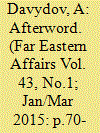

|
|
|
|
|
| Summary/Abstract |
The subject of the round table is quite timely. It is all the more important inasmuch as the assessment of the situation in East Asia given in reports and statements of experts and mass media representatives of various countries, not only foreign, but also Russian, are often based not so much on an analysis of actions of these countries, as on certain initiatives and expressions of their politicians, which sometimes have a too emotional, if not propaganda or provocative, character.
|
|
|
|
|
|
|
|
|
|
|
|
|
|
|
|
| 2 |
ID:
113160
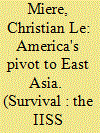

|
|
|
|
|
| Publication |
2012.
|
| Summary/Abstract |
The announcement of a reformed US defence strategy by President Barack Obama and Secretary of Defense Leon Panetta in early January 2012 confirmed a pivot towards the Asia-Pacific as commitments to war fighting in the Middle East and Central Asia subside. Obama, Panetta and General Martin Dempsey, the chairman of the Joint Chiefs of Staff, briefed reporters on 5 January on America's new strategic guidance document, 'Sustaining US Leadership: Priorities for 21st Century Defense'. The product of a review of US defence priorities 'at a moment of transition' for the nation, the document notes that the United States will 'of necessity rebalance toward the Asia-Pacific region'. The principle of the Asia pivot was also signalled by Secretary of State Hillary Clinton in a November 2011 Foreign Policy article in which she noted that 'one of the most important tasks of American statecraft over the next decade will … be to lock in a substantially increased investment - diplomatic, economic, strategic, and otherwise - in the Asia-Pacific region'.
|
|
|
|
|
|
|
|
|
|
|
|
|
|
|
|
| 3 |
ID:
112812
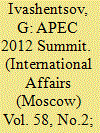

|
|
|
|
|
| Publication |
2012.
|
| Summary/Abstract |
THE SUMMIT of the Asia-Pacific Economic Cooperation Forum (APEC) in Vladivostok promises to be the biggest international event in Russia in 2012.
This is no surprise. Today, the center of international political and economic life is shifting towards the Asia-Pacific region. APEC, the region's main economic forum, includes the world's most powerful economies: USA, China, Japan, and almost half of G-20 member countries, which account for the greater part of global production, including high technologies. The USA assigns great importance to this region in its global forecasts. The Asia-Pacific superpower China is playing a growing geopolitical role.
|
|
|
|
|
|
|
|
|
|
|
|
|
|
|
|
| 4 |
ID:
124800
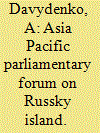

|
|
|
|
|
| Publication |
2013.
|
| Summary/Abstract |
THE 21ST ANNUAL MEETING of the Asia Pacific Parliamentary Forum (APPF), which took place in Vladivostok on Russky Island on January 27-31, 2013, has become the most representative meeting in the entire history of this international parliamentary organization, ending with the adoption of 14 resolutions on key issues of political, trade, economic, and humanitarian cooperation of the Asia-Pacific states.
|
|
|
|
|
|
|
|
|
|
|
|
|
|
|
|
| 5 |
ID:
100702
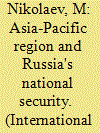

|
|
|
|
|
| Publication |
2010.
|
| Summary/Abstract |
THE NATIONAL SECURITY STRATEGY of the Russian Federation through 2020, adopted a year ago, defines the concept of "national security" as "freedom from internal and external dangers with regard to the individual, society and the state, ensuring the citizens' constitutional rights, freedoms, the worthy quality and standards of life, sovereignty, territorial integrity and stable development of the Russian Federation, and the defense and security of the state.
|
|
|
|
|
|
|
|
|
|
|
|
|
|
|
|
| 6 |
ID:
110523
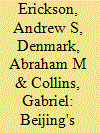

|
|
|
| 7 |
ID:
130610
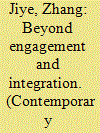

|
|
|
|
|
| Publication |
2014.
|
| Summary/Abstract |
As part of its new strategy of "retuming to the Asia-Pacific region", the A Obama administration has adopted some tough economic policies towards China, notably promoting the Trans-Paci?c Partnership (TPP) and attempting to establish new rules of international trade and investment aimed at strengthening economic ties with other Western countries through the Trans-Atlantic Trade and Investment Partnership Agreement(TTlP ), both of which tend to compress the geopolitical space for China's economic rise. The administration is also using a 'green barrier' to suppress the development of China's high-tech industry, and using economic diplomacy and investment restrictions against Chinese state-owned enterprises. This paper seeks to examine and analyze the causes of shifts in the U .S. economic strategy towards China.
|
|
|
|
|
|
|
|
|
|
|
|
|
|
|
|
| 8 |
ID:
111770
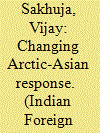

|
|
|
| 9 |
ID:
104227


|
|
|
|
|
| Publication |
2011.
|
| Summary/Abstract |
The state of the world in 2010 can be summed up in a single word: symbiosis. Chaos and change feed on each other in a phenomenon that mirrors the tendency towards change in today's international strategic landscape. This article attempts to create an overview of the most important features and trends of the situation by looking at shifts in major power relations, the rise of the Asia-Pacific region, geo-strategic upheavals, tension on the Korean peninsula, military security, world economy and China's diplomacy. It asserts that chaos is not necessarily a bad thing.
|
|
|
|
|
|
|
|
|
|
|
|
|
|
|
|
| 10 |
ID:
113599
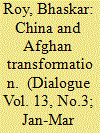

|
|
|
| 11 |
ID:
115194
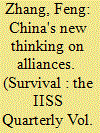

|
|
|
|
|
| Publication |
2012.
|
| Summary/Abstract |
In December 1949, Mao Zedong, paramount leader of the newly founded People's Republic of China, travelled to Moscow to negotiate a military alliance with the Soviet Union. Within barely two decades, however, not only had the alliance collapsed, but the two former allies had become bitter ideological and military adversaries. Strategic exigencies compelled the Chinese leadership to seek rapprochement with the United States, producing a quasi-alliance between the two erstwhile enemies after 1972. In January 1979, during his visit to Washington, Deng Xiaoping sought to nudge the United States toward developing a de facto, if informal, alliance with China in order to secure American support for China's impending invasion of Vietnam. During the last decade of the Cold War, China and the United States also maintained a degree of strategic cooperation against the Soviet Union.
|
|
|
|
|
|
|
|
|
|
|
|
|
|
|
|
| 12 |
ID:
113563
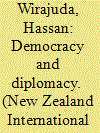

|
|
|
|
|
| Publication |
2012.
|
| Summary/Abstract |
Hassan Wirajuda comments on Indonesia's leadership in the promotion of democracy in ASEAN and the Asia-Pacific region.
|
|
|
|
|
|
|
|
|
|
|
|
|
|
|
|
| 13 |
ID:
138748
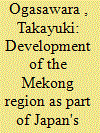

|
|
|
|
|
| Summary/Abstract |
Japan's active engagement in the development of the Mekong region since the 1990s needs to be understood not only from an economic but also from a diplomatic perspective. Japan seeks to collaborate with ASEAN in facilitating multilateral “political dialogue” in the Asia-Pacific region and building an East Asian order based on “universal values” such as democracy and the rule of law, and the Mekong region could be the “weakest link” of ASEAN. After outlining Japan's twenty-year undertaking to cultivate Mekong-Japan cooperation, the author suggests that it is time to broaden the scope of the cooperation and accelerate Japan's “proactive contribution to peace” policy to cope with the changing security environment.
|
|
|
|
|
|
|
|
|
|
|
|
|
|
|
|
| 14 |
ID:
106549
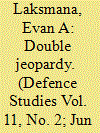

|
|
|
| 15 |
ID:
103007
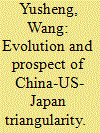

|
|
|
| 16 |
ID:
137579
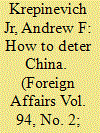

|
|
|
|
|
| Summary/Abstract |
In the U.S. military, at least, the “pivot” to Asia has begun. By 2020, the navy and the air force plan to base 60 percent of their forces in the Asia-Pacific region. The Pentagon, meanwhile, is investing a growing share of its shrinking resources in new long-range bombers and nuclear-powered submarines designed to operate in high-threat environments.
|
|
|
|
|
|
|
|
|
|
|
|
|
|
|
|
| 17 |
ID:
114629
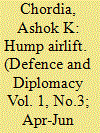

|
|
|
|
|
| Publication |
2012.
|
| Summary/Abstract |
The recent wars in Iraq and Afghanistan have underscored the
importance of airlift as an element of air power. On display has been
the formidable airlift capability of the US - the ability to deliver
almost anything, anywhere, anytime. The foundation of this massive
capability was laid during World War II. The fall of Rangoon to the
Japanese, and the eventual blocking of Burma Road in March 1942
had disrupted the supply lines, leaving airlift as the only option to
maintain the forces in China. Failure to supply would risk substantial
Chinese territory to the Japanese and, more importantly, a defeat
in China would relieve a part of the more than one million strong
Japanese force, to cause havoc elsewhere in the Asia-Pacific region.
The Hump
1
airlift stands out for the dogged determination of the
aircrew who flew under extreme conditions and hauled tonnes of
supplies, equipment, vehicles, arms, ammunition and thousands of
personnel across the Himalayas from India to China.
|
|
|
|
|
|
|
|
|
|
|
|
|
|
|
|
| 18 |
ID:
104090
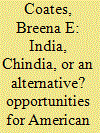

|
|
|
|
|
| Publication |
2009.
|
| Summary/Abstract |
There is an undeniable power surge in Asia, primarily in India and China. Speculation about a strategic joining of forces of India and China into a muscular economic alliance known as "Chindia" has been floated. Despite once being bitter enemies, the two nations have engaged in a recent détente with each other. Building upon each other's strengths helps advance this cause. However, until now the Chindia concept has appeared to be more theoretical than practical in nature because of lingering boundary issues between the nations. Such an alliance, however, cannot be summarily dismissed. This paper focuses upon how India and China partnering with the United States could form a transregional triangle that would tighten America's grip on power in the Asia-Pacific Region.
|
|
|
|
|
|
|
|
|
|
|
|
|
|
|
|
| 19 |
ID:
109712
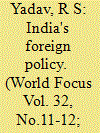

|
|
|
| 20 |
ID:
094090
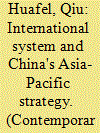

|
|
|
|
|
|
|
|